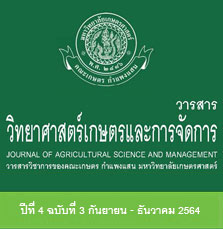การใช้เศษอิฐมอญและถ่านแกลบเป็นวัสดุปลูกที่มีอิทธิพลต่อการเจริญเติบโตและผลผลิตของผักกวางตุ้งฮ่องเต้
คำสำคัญ:
อิฐดินเหนียวเผา, วัสดุปลูกพืช, ภาวะการเป็นปฏิปักษ์ของธาตุอาหาร, ถ่านชีวภาพจากแกลบ, สารปรับปรุงดินบทคัดย่อ
ทำการประเมินอิทธิพลของเศษอิฐมอญบดเพื่อเป็นวัสดุปลูกหลัก (basal material, BM) และสัดส่วนของถ่านแกลบ (rice husk charcoal, RHC) เพื่อเป็นวัสดุเสริม (supplement material, SM) สำหรับเป็นวัสดุปลูกในการผลิตผักกวางตุ้งฮ่องเต้ (Brassica chinensis) ปัจจัยที่ใช้ในการศึกษาประกอบด้วย (i) ชนิดของ BM คือ ทรายและอิฐมอญบด และ (ii) สัดส่วนของ RHC ซึ่งเป็นวัสดุเสริมโดยมีสัดส่วน BM:SM เป็น 1:0, 1:0.5 และ 1:1 v/v โดยทั่วไปแล้ว อิฐมอญบดลดมวลชีวภาพของส่วนเหนือดินของผักกวางตุ้งเมื่อเปรียบเทียบกับทราย การเสริม RHC ในวัสดุปลูกที่มีสัดส่วน BM:SM เป็น 1:0.5 v/v ทำให้ผลผลิตของผักกวางตุ้งเพิ่มขึ้นเมื่อเปรียบเทียบกับ 1:0 v/v อย่างไรก็ตาม การเพิ่มสัดส่วนของ RHC เป็น 1:1 v/v ทำให้มวลชีวภาพส่วนเหนือดินของผักกวางตุ้งฮ่องเต้ลดลงเมื่อเปรียบเทียบกับวัสดุปลูกที่มีสัดส่วนของ RHC ต่ำกว่า (1:0.5 v/v)
เอกสารอ้างอิง
Abrishamkesh, S., M. Gorji, H. Asadi, G. H. Bagheri-Marandi and A. A. Pourbabaee. 2015. Effects of rice husk biochar application on the properties of alkaline soil and lentil growth. Plant, Soil and Environment 61(11): 475–482. doi:https://doi.org/10.17221/117/2015-PSE
Butnan, S. 2015. Biochars differing in properties and rates impacting soil-plant and greenhouse gases in different textured and mineralogy soils. Ph.D. Dissertation. Khon Kaen University, Khon Kaen. 226 p.
Chakraborty, A. K. 2014. Phase Transformation of Kaolinite Clay. Springer, West Bengal.
Chuchaisong, P. and S. Wongthong. 2009. Study of the Properties of Clay bricks Produced in Chon Buri Province. Ungraduate Project. Burapha University, Chon Buri. 67 p.
Costa, H. M. d., L. L. Y. Visconte, R. C. R. Nunes and C. R. G. Furtado. 2003. Rice husk ash filled natural rubber. III. Role of metal oxides in kinetics of sulfur vulcanization. Journal of Applied Polymer Science 90: 1519 –1531. doi: https://doi.org/10.1002/app.12684
Daou, I., G. L. Lecomte-Nana, N. Tessier-Doyen, C. Peyratout, M. F. Gonon and R. Guinebretiere. 2020. Probing the dehydroxylation of kaolinite and halloysite by in situ high temperature X-ray diffraction. Minerals 10(5): 480. doi:https://doi.org/10.3390/min10050480
Ebesu, R. 2004. Home garden oriental leafy greens. Hawaii Cooperative Extension Service Home Garden Vegetable Series no. 10. College of Tropical Agriculture and Human Resources, University of Hawaii at Manoa, Hawaii.
Farhan, A. F. A., A. J. Zakaria, P. N. Mat and K. S. Mohd. 2018. Soilless media culture-a propitious auxiliary for crop production. Asian Journal of Crop Science 10: 1-9. doi:https://doi.org/10.3923/ajcs.2018.1.9
Guntzer, F., C. Keller and J.-D. Meunier. 2012. Benefits of plant silicon for crops: A review. Agronomy for Sustainable Development 32(1): 201-213. doi:https://doi.org/10.1007/s13593-011-0039-8
Haddad, C., M. Arkoun, F. Jamois, A. Schwarzenberg, J.-C. Yvin, P. Etienne and P. Laîné. 2018. Silicon promotes growth of Brassica napus L. and delays leaf senescence induced by nitrogen starvation. Frontiers in Plant Science 9(516): doi:https://doi.org/10.3389/fpls.2018.00516
Haefele, S. M., Y. Konboon, W. Wongboon, S. Amarante, A. A. Maarifat, E. M. Pfeiffer and C. Knoblauch. 2011. Effects and fate of biochar from rice residues in rice-based systems. Field Crops Research 121(3): 430-440. doi:https://doi.org/10.1016/j.fcr.2011.01.014
Hossain, S. S., L. Mathur and P. K. Roy. 2018. Rice husk/rice husk ash as an alternative source of silica in ceramics: A review. Journal of Asian Ceramic Societies 6(4): 299-313. doi:https://doi.org/10.1080/21870764.2018.1539210
Huett, D. O., N. A. Maier, L. A. Sparrow and T. J. Piggott. 1997. Vegetable Crops. pp. 385-464. In Reuter, D. J. and Robinson, J. B. (Eds.). Plant Analysis: An Interpretation Manual. CSIRO Publishing. Collingwood.
Lawanwadeekul, S., T. Otsuru, R. Tomiku and H. Nishiguchi. 2020. Thermal-acoustic clay brick production with added charcoal for use in Thailand. Construction and Building Materials 255: 119376. doi:https://doi.org/10.1016/j.conbuildmat.2020.119376
Lee, S., Y. J. Kim and H.-S. Moon. 1999. Phase transformation sequence from kaolinite to mullite investigated by an energy-filtering transmission electron microscope. Journal of the American Ceramic Society 82(10): 2841-2848. doi:https://doi.org/10.1111/j.1151-2916.1999.tb02165.x
Li, Z. and B. Delvaux. 2019. Phytolith-rich biochar: A potential Si fertilizer in desilicated soils. GCB Bioenergy 11(11): 1264-1282. doi:https://doi.org/10.1111/gcbb.12635
Li, Z., D. Unzué-Belmonte, J.-T. Cornelis, C. V. Linden, E. Struyf, F. Ronsse and B. Delvaux. 2019. Effects of phytolithic rice-straw biochar, soil buffering capacity and pH on silicon bioavailability. Plant and Soil 438(1): 187-203. doi:https://doi.org/10.1007/s11104-019-04013-0
Liang, Y., W. Sun, Y.-G. Zhu and P. Christie. 2007. Mechanisms of silicon-mediated alleviation of abiotic stresses in higher plants: A review. Environmental Pollution 147(2): 422-428. doi:http://dx.doi.org/10.1016/j.envpol.2006.06.008






